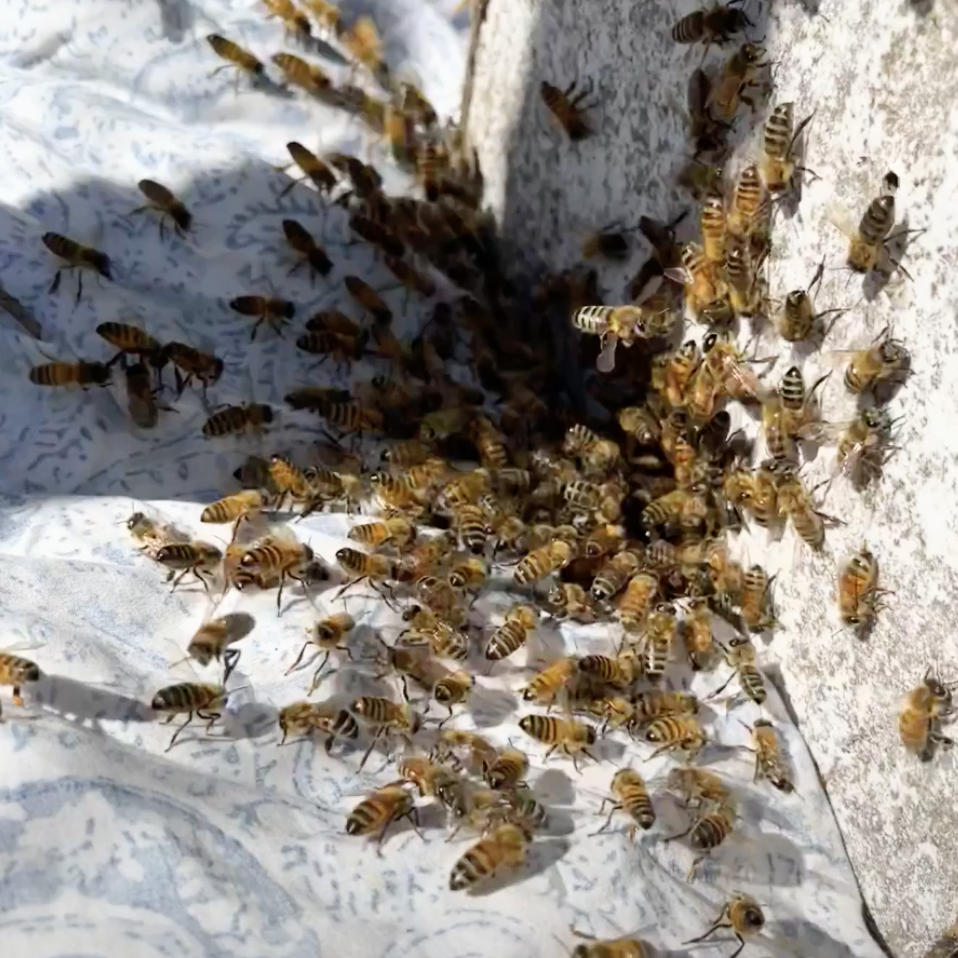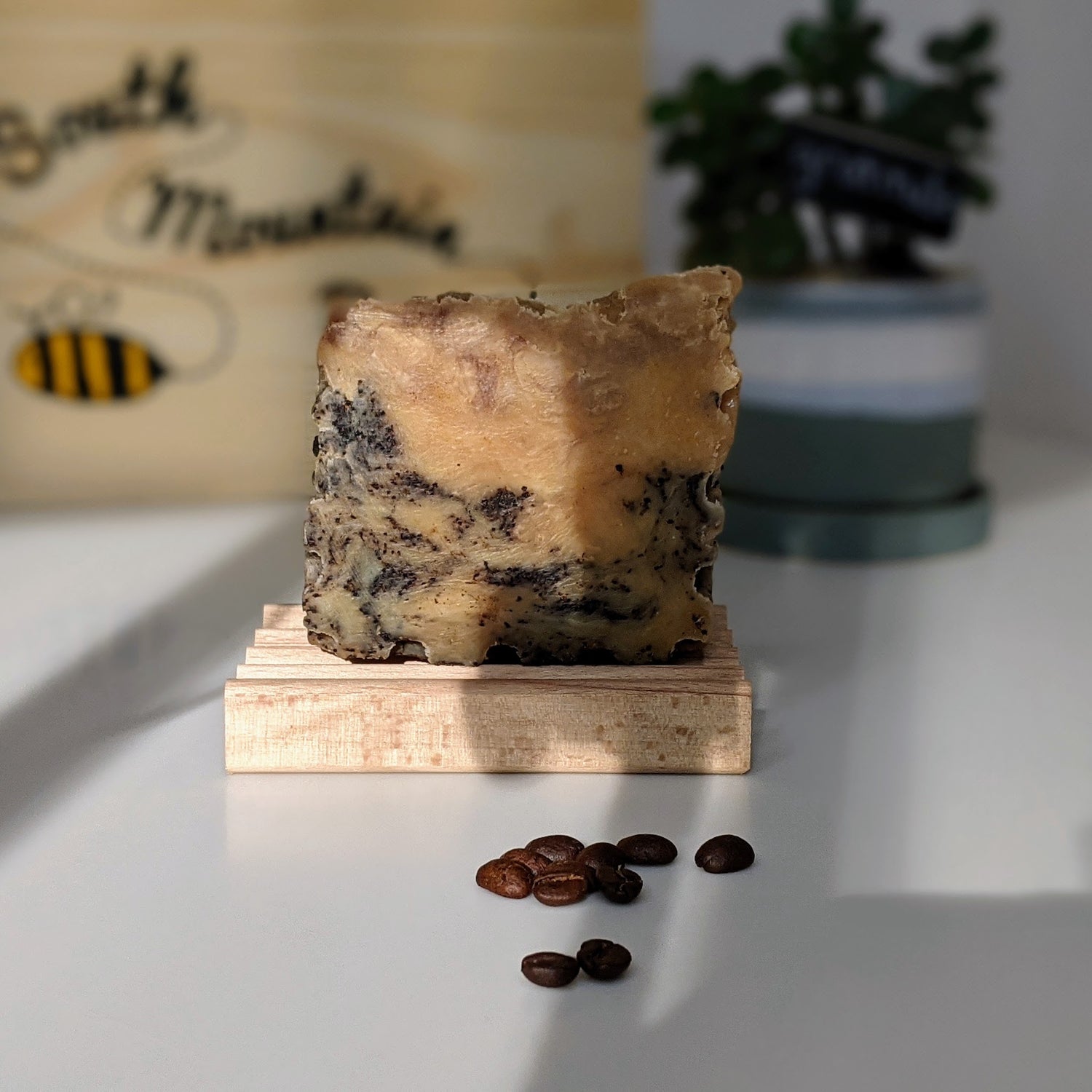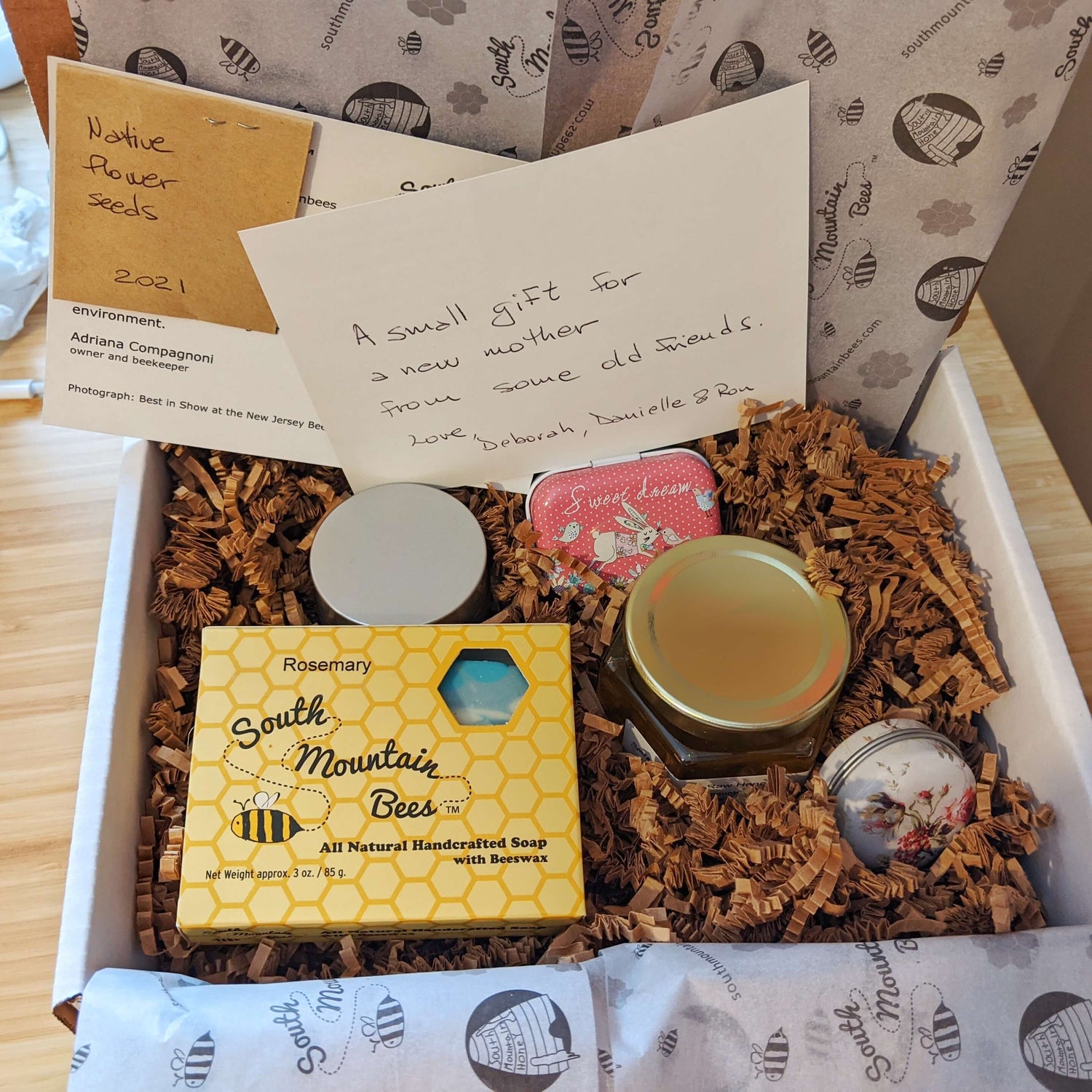After my yoga class on Friday morning I checked my phone, and I saw that somebody had tagged me in a post in the SOMA New Jersey Gardening FB group. The post was about a swarm of bees at Maplecrest Park in Maplewood. Swarm season is already in full swing.
This swarm got us an interview with Alison Stewart on "All of it", WNYC New York Public Radio. Check it out!
We’ve been getting calls for more than a week now, and we’ve been sending people to catch the swarms. I am part of a group of 17 beekeepers who would collect swarms in northern New Jersey, and among us there is always somebody available to help. Reach out, and we’ll get you help (info@southmountainbees.com). You can also search for beekeepers that would remove swarms in NJ by zip code in this page of the New Jersey Beekeepers Association.
The swarm at Maplecrest Park

Anyhow. It was about 1:30PM when they posted that the swarm was still there. I asked my son if he’d help me. We gathered all the gadgets I needed for a swarm collection and there we went. I had the beekeeping suit, gloves, the hive tool, the bee brush, a bucket, a swarm box, and a couple of sheets. The bee suit is not absolutely necessary, since bees are pretty docile when they swarm, but occasionally they can get upset, so I feel more relaxed with the suit and gloves on. The hive tool is a must-have that all beekeepers use, it looks like a putty knife, but a lot sturdier. We use it to pry open hives, lift frames, scrape off beeswax that bees put in inconvenient places, remove propolis, etc. The bee brush has very soft bristles, and it is great for collecting swarms, because brushing the bees into a bucket is a gentle way to convince them to move. The swarm box is a small beehive also known as a nuc (for nucleus colony) box with some old frames of honeycomb and a swarm lure to let the bees know that the box could be their new home. The sheets are useful for collecting the swarm later on. I place the sheet on the ground under the swarm, and set the swarm box in the middle of the sheet. When I go back to collect the swarm, I simply wrap the box with the sheet so that bees don’t fly around in the car, and carry the box in my arms like a baby.

Catching the swarm
We get to the park and locate the tree with the swarm. The tree is a dead young oak tree, with a trunk of about four inches in diameter. We went back to the car to get our gadgets, and as soon as we set the swarm box on the pavement next to the car, we were greeted by three bee scouts who started checking it out. A few other bees got into the trunk of the car checking out all those bee smelling goodies we were carrying. We could tell that the bees were actively looking for a new home. My son helped me carry all the equipment, and place the sheets and the swarm box under the swarm at the base of the tree, and since he was not suited up, he stayed a few yards away taking pictures. The swarm was about 8 feet above the ground, so it was just beyond my reach. I managed to shake the young dead tree, and about a third of the swarm fell into the bucket. I pour the bees into the swarm box, and they stay there.
That’s a good start. It can be very frustrating when they fly right back to join the swarm on the tree.
After a few shakes I got most of the bees into the box, and I used the bucket as a stepping stool to reach the bees left on the trunk with the bee brush.

The queen is here!
I spotted the queen on the edge of the swarm box. I tried to catch her, but she’s fast, and unlike the heavy pregnant queens in the hive, a slender queen in a swarm could fly, and she disappeared into the crowd of bees pretty quickly. Something magic happened at that moment. The bees decided that they liked their new home. They started fanning their wings spreading pheromones telling the other bees to come down from the tree and join them in the new royal apartments.
Accepting their new home
The bees on the tree also got the message, and there were some bees who stayed on the tree fanning their wings and spreading pheromones to tell the other bees to come down. They formed a path for the bees to descend. Pretty neat!
Now we need to wait
At this point we need to wait a few hours. The bees on the tree already know where to go, and any scouts that were looking for a new home will eventually come back and discover that they are moving to a new home. It was around 3PM, and in a couple of hours all the bees would gather in the box, and I’ll be able to wrap them with the sheets, put them in the car, and carry them home.
As we are leaving I mentioned, maybe we should call the police and let them know we left the box here. My son then said: Mom, who’s going to take a box of bees? I agreed that it was unlikely that anybody would approach the box, and we left, happy to see how the bees were flying into their new residence.
The big surprise. The bees are gone!


We go back to the park two hours later, and as we approach the park, I don’t see the box. We park, we go to the tree, and all we see is that the grass underneath where the swarm box was is gone, and there are track marks on the grass.
This doesn’t look good.
And now what?
My son is driving, I had left my phone at home, and I’m thinking now what? Who could have taken the bees? I went back to the FB post to ask if anybody saw anything. I contacted Annemarie, my neighbor and beekeeper friend, to bounce off some ideas, but I have no clue what to do. At this point it is after 6PM on a Friday, and people are getting ready for their weekend. Who will answer the phone?
I tell my husband, I’m going to call the police, and see if they know anything about it. At least to report the missing property. I called and I introduced myself as the beekeeper who was collecting the swarm at Maplecrest Park in Maplewood, and that the swarm box was missing. The police knew exactly what I was talking about. They asked me what color the box was, and when I said, white, they said, was it by Forest street? They informed me that the Maplewood Department of Public Works (DPW) had it. That they were already closed, and that I could contact them again on Monday. A blend of emotions flooded my head: relief to know where they were, concern as to what to do next, and worry about the state of the bees and the swarm box seeing that it was probably lifted/crushed with heavy equipment. Waiting until Monday wasn’t an appealing option.
I then decided to call my friend Liz who works at the South Orange DPW (next town over) to see if she had any connection to the Maplewood DPW, and if she could get me in to pick up the bees. She couldn't help but through the wonders of FB groups and supportive local officials and friends I was able to get in touch with Cesare Riccardi, the director of the Maplewood DPW, and we agreed to meet at the recycling site early in the morning.
Why early in the morning?
I was told the box was damaged in the process, and I wanted to try to retrieve the bees before they decided to start exploring the area to find a new home, since it would be hard to get most of them, if they are out and about. Bees start flying mid morning, so we agreed that 7-7:30 AM was a good time. I don’t particularly enjoy waking up early on a Saturday morning, but sometimes we don’t get to choose. Sigh.
My fellow beekeeper and friend Carolina called me in the evening to try to figure out what happened. I was able to reconstruct what happened through different posts, messages, and talking to the director of the DPW. It turns out that people got scared of the box of bees and called the police. The police called the DPW, and they picked up the bees and took them to the DPW site. They realized they were honeybees, and decided to try to save them. Carolina said she’d help me in the morning.
I woke up before the alarm clock and started to get ready for swarm collection take 2. I got another swarm box, just in case the original one was not in good shape, 6 honeycomb frames to fill the box, the smoker and smoker fuel, since I didn’t know if we’d need to calm them down, another couple of sheets, the bee suit, and the gloves.
I texted Carolina in the morning, and said: I’m on my way. She texted me back saying: I’m on my way too. We met at DPW, waited a few minutes in the driveway, and called to see if we could get in to get the bees. The director greeted us with a big smile. He was happy to see us suited up and ready for the job ahead. He walked us to the bees and shared that the bees were flying all over the day before.
My heart sank when I saw the mangled box and the frames piled up with soil and grass over them. It looked like the beekeeping books' pictures showing what bears do to beehives. There was a tiny cluster of bees on the edge of the top frame, and I thought they were gone.

The moment we started to remove the soil on top of the frames, they started to fly. So we got the new swarm box, to try to put them in, and as we lifted the frames we could see that in the gap under the frames there were a lot more bees hanging together. That gave us hope back. Phew! We didn’t see the queen, but we didn't want to disturb them looking for her. The goal was to get as many bees as possible inside the new box as quickly as possible. Luckily the ones we couldn’t pick up marched happily into the new box, we wrapped them with the sheets and set them in the car.
One of the brave workers that picked up the bees joined us, and he explained that they thought somebody had abandoned a box of bees in the park. I explained that the bees were in the tree, and we were in the process of getting them in the box.
It was all a big misunderstanding, and a good lesson to learn.
As we were leaving the DPW yard, we had a good chat about bees, and I said: you can always call me when you need help with bees. Cesare asked: what about hornets? I said: those are yours! And we all laughed.
The bees have a new home
Back at home in the bee yard with Carolina, we gave the bees a final home. Since we didn’t see the queen, I took resources from two of my other hives to make sure they could make a queen, if they needed one. We gave them a frame of fresh eggs that they could use to make a new queen, and a queen cell, which is a queen that another hive was making. If they needed a queen ASAP, a virgin queen would hatch in a few days from that cell. If they don’t need a queen, the bees will “take care” of the queen cell, and they won’t use the eggs to make a new queen, and instead nurse them to become worker bees. We also gave them a couple of frames of emerging brood. Emerging brood is brood that is actively hatching. You can actually see the heads of bees popping out of the cells. That will quickly increase the population, and give this poor swarm a little boost to help them succeed, and make delicious honey. We added a feeder inside their new home, and I made a gallon of simple syrup to help them get started. It is a lot of work for a small swarm to gather food to build a new home, and the sugar syrup is emergency food to help them build comb.


Thank you, Carolina, for these lovely pictures!
Here's the syrup I made to feed the swarm.

Lessons learned
Collecting a swarm from a public park is different from collecting a swarm from a private property. I am used to collecting swarms from people’s homes, and I always talk to the home owner to explain next steps and what to expect. In a public space, we need to inform the local authorities or the police.
I should have followed my initial gut instinct and call the police, but then I wouldn’t have learned so much, and I would have missed this opportunity to educate the local community about what to do when they see a swarm of bees or a swarm collection in progress.
I need to make a sign that says the beekeeper is coming back. The sign will inform passers by that it is all being taken care of. As far as we know, nobody got stung, so the bees weren’t a threat to anybody at any point during the process of catching the swarm.
My favorite takeaway is that I now met people who can use my expertise as a beekeeper to help our local community.
All’s well that ends well.
In the meantime, if you want to learn more about why bees swarm, here's a post I wrote last year.
Until the next swarm!





2 comments
You are amazing! Thank you! Mother Earth thanks you, too! ♥️🐝
What an engaging story! I’m so glad you were able to collect the bees.
Where did the other bees go? Did some leave the DPW to move to other places?